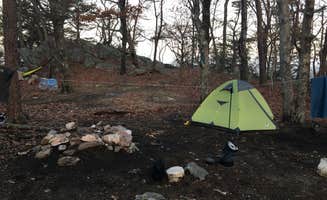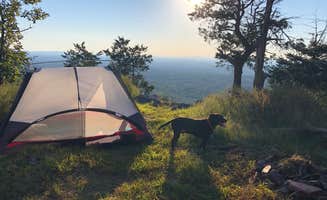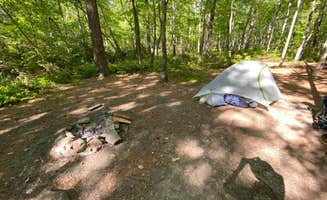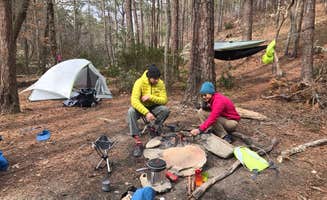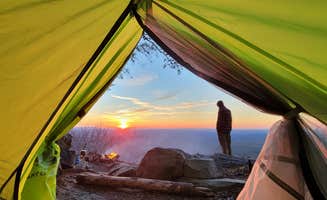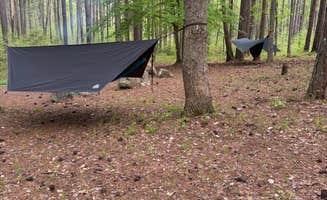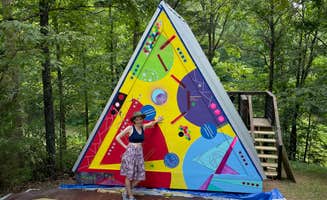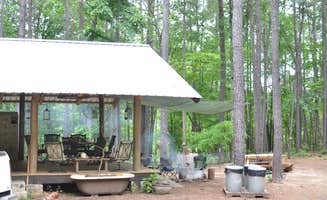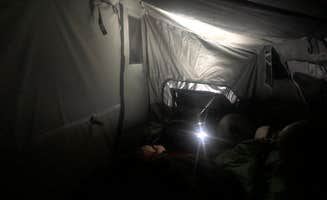Tent camping near Oxford, Alabama centers around the Talladega National Forest, where rugged terrain creates diverse microclimates across elevations ranging from 600 to 2,400 feet. The area's tent camping season peaks from March through November, with summer temperatures often reaching the high 80s but cooling significantly at night due to elevation. Winter camping remains possible but requires preparation for temperatures that can drop below freezing after sunset.
What to do
Swimming at Devils Den Falls: Located along the Chinnabee Silent Trail, this swimming hole offers relief during hot months. "There is a small level area before you begin the final climb up to the trail intersection. It is modestly level and provides a clear space large enough for about a single tent," notes one Pinhoti Trail Backcountry Campground visitor.
Winter hiking: The cooler months provide clearer views when foliage thins. "This shelter is situated at the top of the hill after crossing the falls and it has a magnificent view of the surrounding mountains," explains a camper at Cheaha Falls Shelter.
Stargazing: Minimal light pollution creates excellent night sky viewing. "After building a fire, making dinner and roasting marshmallows, we sat to enjoy the most beautiful sunset and then the stars emerging into a brilliant light show," describes one visitor to McDill Point Backcountry.
What campers like
Budget-friendly camping: Most primitive sites in the area cost $5 per night or are free. "Beautiful camp sites well maintained and only $5 a night," confirms a visitor to Turnipseed Campground.
Wildlife observation: Spring and early summer bring active wildlife. "We saw and heard a lot of birds and wildlife here! Explore as many trails as you can... There is a ton of diversity in this area, including lovely plants, geology, animals, and deep almost completely undisturbed wilderness."
Seclusion: Many sites offer privacy from other campers. "It's very quiet and peaceful. I love this campsite," notes a Turnipseed camper, while another adds, "It was mostly empty. Saturday night it was half full. Peaceful, clean, nice hiking."
What you should know
Water availability: Most backcountry sites require filtering water from streams that may run seasonally. "This site has no water access any time of year (unless it is actively raining) so make sure to carry in any water you will need," warns a camper at Chinnabee Silent Trail Backcountry Site 9.
Site selection timing: First-come, first-served rules apply at most sites. "It is very nice to just drop five dollars in a box and go camp there are no attendants here," explains a Turnipseed visitor, adding "It's first come first serve tho but there's about 10 or so campsites too choose from."
Limited facilities: Most sites offer basic amenities only. "There are outhouses but no water, some sites have old picnic tables and/or a fire pit," notes a camper, while another mentions, "No running water or showers but there is an outhouse."
Tips for camping with families
Start with shorter hikes: Choose sites with minimal hiking distance for younger children. "We started our hike in from Chinnabee silent trail parking and headed up toward chinnabee lake. We found this spot nearby the big swimming hole 'devils den' about 1/2 a mile from the chinnabee lake parking area."
Consider shelters during unpredictable weather: The area's shelters provide protection during spring storms. "The site has a large area on the first floor where you could set up several sleeping bags and then there is an additional closed off area in the loft that is dark and dingy but very clean and perfect if the weather is ugly," explains a visitor to Blue Mountain Shelter.
Plan group sites carefully: Some locations accommodate larger family groups better than others. "There are around 4-5 different fire pits and plenty of flat space for at least 5 if not more tents," explains a visitor to Pinhoti and Skyway Loop Intersection Campground, adding "This is by far one of the best sites in the area for large groups."
Tips for RVers
Size restrictions: Most tent camping areas near Oxford cannot accommodate large RVs. "I would not recommend this campground to anyone in a large RV," cautions a Turnipseed visitor, while another notes it's "Best for tent and van camping. Maybe a tiny RV."
Consider Cheaha State Park: While primitive sites don't accommodate RVs, nearby improved campgrounds do. "Some of the campground sites are right under street lights (these are pointed out on the campground maps) and a few of the pull-though sites have the road in front of your camper (as opposed to behind) leaving no room to use your awning."
Plan for limited connectivity: Cell service is minimal throughout the area. "No cell reception at lower campground (and spotty in general, but in all honesty this is more a PRO unless you have work or other obligations)."


